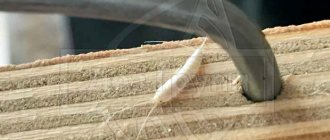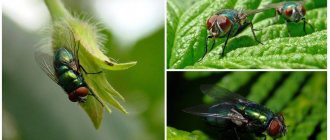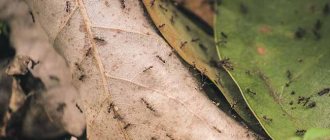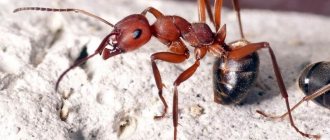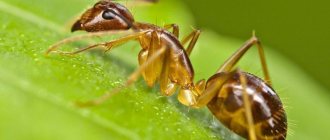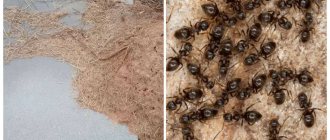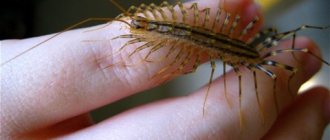The corn ground beetle is a serious pest of grain crops. It causes significant damage to agriculture.
Beetle sitting on an ear of wheat
Properly organized control of corn ground beetles will preserve the harvest.
You may also be interested in our article: Ground beetle, dangerous pest or beneficial insect?
Description
The bread ground beetle is one of the most common representatives of the order of Coleoptera insects, which make up the largest family of beetles (about 50,000 species):
- adults grow up to 2.5 cm;
- have an oval-shaped convex body, painted black with a slightly pronounced metallic tint;
- the surface of the abdominal part of the beetle is brown in color.
The insect has resinous-black thread-like antennae and 5-segmented limbs. The convex elytra have relatively deep, finely punctuated grooves. The beetle has strong and at the same time blunt jaws at the ends. The ground beetle is pictured below.
Bread ground beetle
Appearance
The common ground beetle is a beetle whose length is 10-15 mm.
This species has characteristic external features:
- The body is oval in shape.
- Rich black color with a metallic sheen.
- Powerful jaws with blunt ends. It is with their help that the insect is able to gnaw through the hard layer in plants, making its way to the pulp, and also eat stale bread crumbs.
- Long antennae with many bristles.
- Long legs, thanks to which the ground beetle is able to move quickly. The forelimbs have characteristic serrations that help her clean her whiskers.
- The elytra cover almost the entire abdomen.
The size of the beetle's wings can determine the degree of hospitality of your home: if they are short, it means the insect is comfortable and there is no need to migrate.
Lifestyle and habitat
The ground beetle is nocturnal, hiding during the day in its shelter (under snags, stones or tree roots). If a ground beetle has settled in a house, it usually hides in the joints of old furniture.
In natural conditions, the favorite habitat of the ground beetle is fields of winter wheat, rye, barley, oats and even corn.
On a note!
The pest gnaws the scales of the ear, damaging the primordia of the grains and the already ripening grain. In the absence of grain crops, the beetle can satisfy its hunger even with leeks.
Control measures
Agrotechnical measures
- Maintaining crop rotation.
- Thorough harvesting of the previous grain crop.
- Stubble peeling.
- Deep plowing of the soil.
- Additional cultivation. [6]
Chemical methods
In addition, the following sources were used when writing the article: [7]
Leave your review:
Reviews:
Compiled by: Grigorovskaya P.I.
Last update: 12/07/17 20:58
Reproduction
In the presence of favorable conditions of heat and humidity, bread ground beetles begin to actively mate, after which the females lay eggs (from 50 to 250 pieces) in the soil. Dry weather reduces the fertility of ground beetles.
Insect reproduction After 10-15 days, larvae are born and remain in the soil until frost occurs. They spend the winter there, building a shelter for themselves in the form of a hole. They resume feeding on winter crops until the pupation period. It takes about 3 weeks to form a pupa. One generation of beetles appears per year.
Larvae
The larvae go through several stages of development. Initially they are grayish-white. They stay like this throughout the cold season.
When the frost stops, the larvae move closer to the soil surface, where they begin to take up nutrients. This stage lasts from 3 to 5 weeks.
Eating grass, the larvae gradually change color to dirty green and even black. By mid-spring they turn into pupae.
Where do bugs come from?
A ground beetle can find its way into an apartment in the following ways:
- beetle larvae can be carried into the house on shoes;
- together with products: cereals, flour or potatoes;
- with wood for lighting a fireplace or heating a stove;
- An unpleasant odor and remains of animal food in a pet’s cage can attract the attention of insects;
- Considering that beetles always fly towards the light, they enter the house through windows not protected by mosquito nets.
When night comes, a pest that has crawled into the house goes in search of food, which can be cereals, as well as crumbs and leftover food left on the table. With its rustling sound, the beetle deprives you of sleep and rest, often falling from the ceiling onto the bed. If the insect’s attempt to get food is successful, then this is a favorable signal for reproduction. Therefore, when a ground beetle appears in the house, it is necessary to take urgent measures to combat it.
Prevention measures
It is necessary to carry out wet cleaning every day - this is the first and main preventive measure, because these beetles love dust, dirt and crumbs. If any wooden furniture is brought into the apartment, it should be treated in advance with special anti-beetle agents. If you don’t want to treat furniture with household chemicals, you can get by with a folk remedy – vinegar water or soda.
Due to the fact that ground beetles often live in cereals, flour and potatoes, it is necessary, after purchasing all these products, to review them and place them in glass containers. Flour should always be sifted through a sieve. It must be kept in a tightly closed container. Potatoes need to be sorted and washed.
How to get rid of bugs in an apartment
Destruction of beetles in the house It is quite simple to destroy the malicious pest of the fields.
- Before you get rid of ground beetles in your apartment, you first need to find the place where they live. Then do a general cleaning, placing all bulk products in sealed containers.
- To treat the habitat of bread beetles, you can use a vinegar or soda solution, or use insecticidal agents such as Dichlorvos, Karbofos or Fufanon.
- If cereals or flour are infected with ground beetles, it is preferable to get rid of them completely. If this is not possible, the products should be calcined in the oven for 20-30 minutes.
- You can also fight bread beetles using ultraviolet rays by heating contaminated products in the sun for 6 hours.
- Cold has no worse effect on pests. Air temperatures below 15 degrees are detrimental to insects.
- Use baits based on boric acid.
- Plants with a strong aroma can also fight the uninvited guest. These are cloves, garlic, bay leaf.
The article was compiled using the following materials:
Vasilyev V.P. Pests of agricultural crops and forests in three volumes. Volume I. Harmful nematodes, mollusks, arthropods (part one). Team of authors. Ed. acad. V.P. Vasilyeva. K., “Harvest”, 1973, p. 496 p. OK
Vereshchagin L.N. Pests and diseases of cereal crops. - K.: Univest Marketing, 2001. -128 p.
State catalog of pesticides and agrochemicals approved for use on the territory of the Russian Federation, 2014. Ministry of Agriculture of the Russian Federation (Ministry of Agriculture of Russia) Download >>>
Kryzhanovsky O.L., Insects and mites - pests of agricultural crops. Volume II. Coleoptera. L: Publishing house “Nauka”, 1974.- 336 p.
Orlov V.N. Pests of cereal crops. – M. Printed City, 2006 – 104 p.
Benada Y. Atlas of diseases and pests of oilseeds. A team of authors led by J. Benada, I. Shediva, J. Spacek. Artist F. Severa. – Prague: State Publishing House of Agricultural Literature, 1968. – 200 pp., illus. Illustrations from the book. ©
How to protect crops on the field
The following methods will help you get rid of bread ground beetles from crop areas:
- Follow the rules of crop rotation.
- Harvest grain crops at early stages of ripening. Moreover, you should immediately remove straw from the field and plow the soil to a depth of at least 20 cm.
- Attract natural enemies: various parasitic and predatory insects.
- Use treated seeds for sowing. Spray young crops with insecticidal preparations in a timely manner.
- Use insecticides Aktara, Eforia, Cruiser during the period of active feeding of the larvae.
Methods for identifying and recording ground beetles. Economic threshold of harmfulness
The census is carried out by soil excavation of areas 0.25 m2 in size, 30 cm deep. Samples are taken in a checkerboard pattern (16 samples per 100 hectares). All fields sown according to the grain predecessors, as well as crops adjacent to the harvested grain grains, are examined. In autumn, the economic threshold of harmfulness is 2 larvae per 1 m2.
In March - April, after the resumption of the winter crop growing season, a survey is also carried out to clarify the need and volume of chemical treatments. The density of larvae is determined, they are divided by age and activity (feeding or not). When distributed evenly over the field, it is recommended to treat the field with insecticides completely; when colonized with spots, it is recommended to treat them selectively. In June, during the period of milky and waxy ripeness of grain, in order to clarify the population of winter crops with beetles, the edge strips are examined without the use of excavations from 6-7 to 10 a.m., or from 6 p.m. to dusk, when the beetles are on the ears. If there are 8-10 beetles per 1 m2 on crops, the use of insecticides is necessary.
Damage
Corn ground beetles love to feast on cereal crops, damaging large areas of crops. Both larvae and adult beetles cause damage. The first ones eat the first leaves from winter crops. The latter suck out the milky interior of the young grain. The most commonly affected crops are wheat, rye and barley. Sometimes the grain ground beetle does not disdain oats and corn. In the absence of cultivated crops, he is content with ordinary leeks.
One of the most effective acaricides that are suitable for treating plants against ticks is Omite. Attractants for attracting pests and their subsequent destruction can be made with your own hands. You will find effective recipes in this article.
Insecticides are used to control harmful insects. You will find the classification of these funds at the link.
Nutrition
Among the insect family, there are species with a mixed type of diet that eat both plant and animal food. The genus Ground beetles feed on:
- insects;
- shellfish;
- caterpillars;
- grape snails;
- earthworms;
- phytophages;
- plant foods.
The predator lies in wait for its prey in a shelter or quickly catches up with the help of long, muscular, long legs. Thanks to extraintestinal digestion, it holds it with powerful jaws, pouring out a secretion from the midgut to soften the tough tissue.
Any chitinous cover easily yields to strong jaws. The process of absorption and digestion takes place quickly from 2 to 4 hours, turning into a liquid pulp. When the snail eats, it gnaws out the mollusk itself, leaving its house intact. The satiated insect burrows into the ground for several days.
The herbivorous ground beetle is a crop pest in the fields where it constantly spends its time. Loves agricultural grains of wheat, barley and rye. At night it climbs onto the ears and eats the grains.
After harvesting, it is firmly concentrated in areas with spilled grain. It also consumes weeds, gnawing off young leaves and leaving only veins. Enjoys nectar and pollen on flowers.

